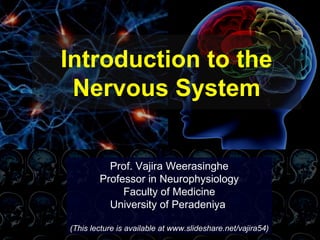
Y2 s1 introduction to the nervous system 2015
- 1. Introduction to the Nervous System Prof. Vajira Weerasinghe Professor in Neurophysiology Faculty of Medicine University of Peradeniya (This lecture is available at www.slideshare.net/vajira54)
- 3. Why study nervous system? Neurological diseases are disabling and debilitating and very little treatment is available
- 4. Migraine (severe headache) Stroke or paralysis Parkinsonism Alzheimer’s disease (Memory loss) Muscle wasting
- 5. Why study nervous system? Activities such as walking and running and various forms of exercise and sports require proper functioning of the nervous system
- 7. Controlling system Nervous system is the main controlling system of the body Quick Electrical Endocrine system also controls body functions Slow Chemical
- 8. Nerve impulses • It controls other organs by sending electrical messages called nerve impulses It is also the main communication system (like
- 9. What does it do ? Functions of the nervous system 1. Receives sensory messages from the external environment 2. Organizes information and integrates it with already stored information 3. Uses integrated information to send out messages to muscles and glands, producing organized movement and secretions 4. Provides the basis for conscious experience
- 10. Functional Subdivisions • Sensory functions feeling, eg. pain • Autonomic functions control of blood pressure • Integrative functions eg. reflexes • Motor functions movement, eg. walking • Higher functions memory, learning
- 11. Anatomical Subdivisions • Central Nervous system Brain and spinal cord • Peripheral Nervous system Cranial Nerves & Peripheral Nerves • Autonomic system sympathetic & parasympathetic
- 12. Brain - Lobes • Brain contains the main controlling centres • Frontal lobe Located in the front Performs motor functions • Parietal lobe Located laterally Performs main sensory functions
- 13. Brain - Lobes • Occipital lobe Located in the back Performs visual functions • Temporal lobe Located laterally Performs hearing functions
- 14. Spinal cord • Functions To transmit impulses to and from the brain to the periphery To cause reflex action To process information
- 15. Peripheral nervous system • Cranial nerves There are 12 cranial nerves which connects brain & brainstem with different organs of the head and neck region • Spinal nerves There are several pairs connecting different segments of the spinal cord with peripheral organs
- 16. Cranial nerves I-Olfactory nerve - smell II-Optic nerve - vision III-Occulomotor nerve - eye movements IV-Trochlear nerve - eye movements V-Trigeminal nerve - mastication VI-Abducens nerve - eye movements VII-Facial nerve - facial expressions VIII-Vestibulocochlear nerve - hearing, balance IX-Glossopharyngeal nerve - taste X-Vagus nerve - parasympathetic XI- Spinal accessory nerve - neck muscles XII-Hypoglossal nerve - tongue
- 18. Brain stem • This is an important part of the nervous system that connects brain with the spinal cord • Many cranial nerves arise from brain stem • It also contain vital centres Cardiac, respiratory functions, consciousness
- 19. Brain stem • It has three areas Midbrain Pons (or pons Varoli) Medulla (or medulla oblongata)
- 20. Cerebellum • This is hind brain • This is connected to the brainstem • Main function is motor coordination • Abnormalities result in difficulty
- 21. Sensory functions • Functions that make us feel the environment • Nerve signals come from the sensory organ towards the CNS Afferent signals • There are different types of sensory modalities human nervous system could feel
- 22. General and special sensations • There are two main types of sensations General sensations Special sensations
- 23. General sensations • Mechanical sensations Touch Pressure Vibrations Stretch • Thermal sensations Hot, cold • Chemical sensation
- 24. Somatic and visceral sensations • Somatic sensations External stimuli sensed by the skin eg. Feeling of hot environment • Visceral sensations Internal sensations sensed by the visceral afferent nerves eg. acidity in stomach
- 25. Special sensations These are specialised sensations Vision Hearing Taste Smell
- 26. Proprioception • Joint and position sensation • Muscles and tendons contain receptors which could feel Muscle length Joint angle Position of bones and joint • This is very important feedback information for movements of muscles
- 27. Motor functions • Movements are of two types Voluntary movements Consciously controlled movements Well thought and planned Involuntary movements Reflex action Control of posture Balance
- 28. Voluntary movements • Planning starts from the brain (frontal lobe) • Modified by various intermediate structures Brainstem Cerebellum • Executed by the brainstem and spinal cord (lower motor neuron)
- 29. Reflexes • Response to a stimulus • This is an involuntary action eg. Hot object touching the hand will cause it to withdraw • This is called withdrawal reflex
- 30. What is a reflex? Stimulus Effector organ Response Central connections Efferent nerve Afferent nerveReceptor Central control
- 31. Reflexes • Reflexes involve many systems of the body • eg. Withdrawal reflex (pain and motor pathways) Pupillary reflex (eye) Salivatory reflex (salivary glands) Swallowing reflex (GIT) Micturition reflex (urinary system) Baroreceptor reflex (blood pressure control) Stretch reflex (main reflex in the motor system)
- 32. Autonomic functions • Controls involuntary functions of the body • Two main divisions Sympathetic Parasympathetic
- 33. Sympathetic system • This is involved in fight or flight reaction • What happens when somebody is excited Blood pressure increases Heart rate increases Respiratory rate increases Increased sweating Pupillary dilatation GIT function suppressed
- 34. Parasympathetic system • This is involved when somebody s resting • Blood pressure decreases • Heart rate decreases • Respiratory rate decreases • Decreased sweating • Pupillary constriction • GIT function increased
- 35. Higher functions • Brain is involved in controlling higher functions • Learning • Memory • Intelligence • They are called cognitive functions
- 36. Basic cell in the nervous system is is a neuron Nerve signals are electrochemical impulses called “action potentials”
